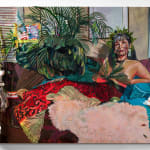Gisela McDaniel
Tiningo' si Sirena, 2021
Oil on canvas, found object, jewellery from subject-collaborator, sound
114.3 x 152.4 x 14 cm
45 x 60 x 5 1/2 in
45 x 60 x 5 1/2 in
Copyright The Artist
Further images
-
(View a larger image of thumbnail 1
)

-
(View a larger image of thumbnail 2
)

-
(View a larger image of thumbnail 3
)

-
(View a larger image of thumbnail 4
)

-
(View a larger image of thumbnail 5
)

-
(View a larger image of thumbnail 6
)

-
(View a larger image of thumbnail 7
)

-
(View a larger image of thumbnail 8
)

-
(View a larger image of thumbnail 9
)

-
(View a larger image of thumbnail 10
)

-
(View a larger image of thumbnail 11
)

-
(View a larger image of thumbnail 12
)

-
(View a larger image of thumbnail 13
)

-
(View a larger image of thumbnail 14
)

Subject sits on her living room couch between two windows gazing at the viewer. She holds a palm frond in her hand to fan no one but herself and wears...
Subject sits on her living room couch between two windows gazing at the viewer. She holds a palm frond in her hand to fan no one but herself and wears a leaf crown traditional to Pasika cultures. She is topless as her famaloa’an (women) ancestors, and even her great grandmother’s would have gone without shame before the arrival of Magellan 500 years ago in 1521. 'Nakedness' had henceforth been deemed 'backwards', first by Spanish Catholicism and later by the white, western American gaze. Part of a t-shirt commemorating her parents/Gisela Mcdaniel's grandparents 'Liberation' of Guam by the U.S. in 1944 is embedded in the painting on the left. The two were among rapidly dwindling war survivors' of the brutal three-year Japanese occupation which began four hours after Pearl Harbor was attacked on December 7th. The island was handily taken, as the U.S. military and their dependents had been intentionally evacuated months earlier in October 1941. She sits on a lamb skin she’d bought for McDaniel as an infant and blue fabric donated by McDaniel's paternal grandmother, reminiscent of the tones of the Pacific and Mariana trench, the deepest part of the ocean over which our island is situated. The bone-carved, Latte Stoned-shaped earrings she wears were crafted by the artisan Hinennge (CHamoru for “faith”), a craft she’d learned from her father who’s since passed. Bleached coral sits to her right and wraps around the thick canvas protruding from the wall. A large artificial plant leans on the couch towards her on the left side. Shells from Guåhan and her own jewelry adorn the surface of the painting and sit in thick paint which has been piped on. Part of a dress is embedded in gesso on the left-hand side. A fake plumeria bought in a market in Guam as well as jewels and shells embellish the surface and the “mask”.












